Where is Bhutan you may ask?
The Kingdom of Bhutan is a peaceful country hidden away within the Eastern Himalayas between heavily industrialized neighbors India and China. A tiny Himalayan country, where you can explore the ancient traditions and cultures, beautiful landscapes and magnificent architecture. Country Bhutan is called Druk Yul by its people, and is known as the “Land of the Thunder Dragon”. It is one of the world’s most beautiful, yet mysterious and secretive places in the globe. It is located on the eastern edge of the Himalayan Mountain region. As a travel destination Bhutan remains unique, sandwiched between its heavily industrialized neighbors China and India. A large part of the area is forested welcoming a diverse ecosystem of flora and fauna. 72% of Bhutan is under forest cover, and all that forest is pristine. The country has become a carbon sink. Being a carbon sink means that Bhutan absorbs over 6 million tons of carbon annually while only producing 1.5 million tons. That is why Bhutan is one of the few remaining global biodiversity hotspots in the world. In a world that is threatened with climate change, Bhutan is a carbon neutral country.
The country stretches from subtropical valleys and plains to snowcapped mountain ranges. This landscape, valley, towns, hamlets makes it the perfect place to hike and trek through the majestic valleys or hills and small mountains by going through the ancient architecture and Buddhist temples.
Bhutan has a rich culture and traditions where most of its 700,000 inhabitants practice the Buddhist and partially Hindu religion. This secluded land has a rich history embedded into the society and shows through the festival re-enactments. Bhutan’s ancient cultural traditions have continued to grow despite the current technological restructuring. It has become the ultimate tourist destination for adventurers, spiritual awakenings, and serene visages.

Bhutan is a small country in the Himalayas. The condition of our environment will always be a central component in humanities happiness that means that environmental protection quickly became a top priority in Bhutan’s political agenda, based ontheir Gross National Happiness (GNH) index model. It started with a promise.
Bhutan a country to Love, Majestic fog enshrouded temples nestled into mountainous terrain is quite often the first image that one conjures up when thinking of Bhutan. That is if one is able to conjure up an image at all. Bhutan is a seldom-traveled destination.
What you need to know to get into Bhutan
Drukair and Bhutan Airline are the Bhutan’s flights enter through the illustrious Paro Valley landing on the International Airport. The airline operates out of nine cities in six countries. No matter where you are in the world, both airlines will get you to the most peaceful place on Earth. Expect expert service and care when you fly in the Bhutan Flight Airbus A319.
Druk Air operates with 3 Airbus 319 on different international sectors and uses ATR – 42 – 500 for Domestic Flights. Airbus 319 has seating capacity of 114 seats. Bhutan Flight operates from Bangkok (Thailand), Kathmandu (Nepal), Delhi (India), Guwahati (India), Bagdora (India) Dhaka (Bangladesh), Singapore, Bodhgaya (India), Mumbai (India) Kolkatta (India).
By surface, entry into Bhutan is possible through southern border town of Phuentsholing. This frontier town is about 6 hours drive from Thimphu and Paro, 4 hours drive from Bagdogra and 7 hours drive from Darjeeling and Sikkim.
HIGH VALUE – LOW VOLUME TOURISM Impacts
Tourism is a vibrant business with high potential for growth and further development. The Bhutan government strongly adheres to a policy of ‘high value, low impact’ tourism, which serves the purpose of creating an image of exclusivity and high yield for Bhutan.
A high volume of tourism may seem like a good thing for Bhutan’s economy, but for the Bhutanese, protecting their culture, traditions and environment is most important. Bhutan’s Royal Government limits the number of tourists entering the country. Officials believed that unrestricted access to the country would have a negative impact on the natural environment and ancient cultural traditions. This belief led to the notion of “High Value, Low Volume” tourism. Tourism must be sustainable and environmentally friendly. The government wanted tourists to understand the feel the deep-rooted culture and traditions, so they would have a higher appreciation for their surroundings.
Tourism has become the second highest economical contributions to the Bhutan economy, after the agricultural industry. The Tourism Council of Bhutan extended the tourism areas to include once protected communities, natural reserves, and ancient cultures.
GROSS NATIONAL HAPPINESS
Why is Bhutan known for the word Happiness?
Bhutan is known famously as the first country in the world to measure progress based on happiness. To do so, the 4th Druk Gyalpo coined the term Gross National Happiness (GNH). From then on, GNH was used to measure the country’s development instead of Gross National Product (GNP).
The happiness of the Bhutanese is more important than material growth and there should be a balance between to two. A GNH Commission was created to take an annual measure of how the people fare. The poll is based on an index of nine domains. Living standards, education, health, cultural diversity and resilience, community vitality, time use, psychological wellbeing, ecological diversity, and good governess are the nine domains that are taken into account. According to the GNH Commission, 81.5% of the population of Bhutan is deeply happy. The Commission is still working on ways to achieve total happiness for 100% of Bhutanese.
WHY SHOULD YOU VISIT BHUTAN?
Look out what Bhutan can offer you
There are many reasons to visit Bhutan. For those who want a relaxing vacation, you will be treated like royalty with traditional massages and hot stone baths. Others may want to travel along the mountain ranges and bask in the glorious landscapes. Some may seek spiritual fulfillment. Visiting monasteries and temples may offer an air of enlightenment. The extra-ordinary geographical diversity and the diverse climate conditions play an important in contributing to Bhutan’s outstanding range of biodiversity and ecosystems, which are worth seeing.
1. Tiger’s Nest Monastery – Hike up to Monastery – known as ‘Taktsang’, is said to be the most spiritual place in Bhutan. The temple sits on the edge of a mountainside above the Paro Valley. The walk is 3,000 feet over the valley where you can experience the peaceful and tranquil Bhutan landscape. The temple was built to commemorate Guru Rinpoche. A temple complex was first built in 1692, around the Taktsang Senge Samdup cave where Guru Padmasambhava is said to have meditated for three years, three months, three weeks, three days and three hours in the 8th century.
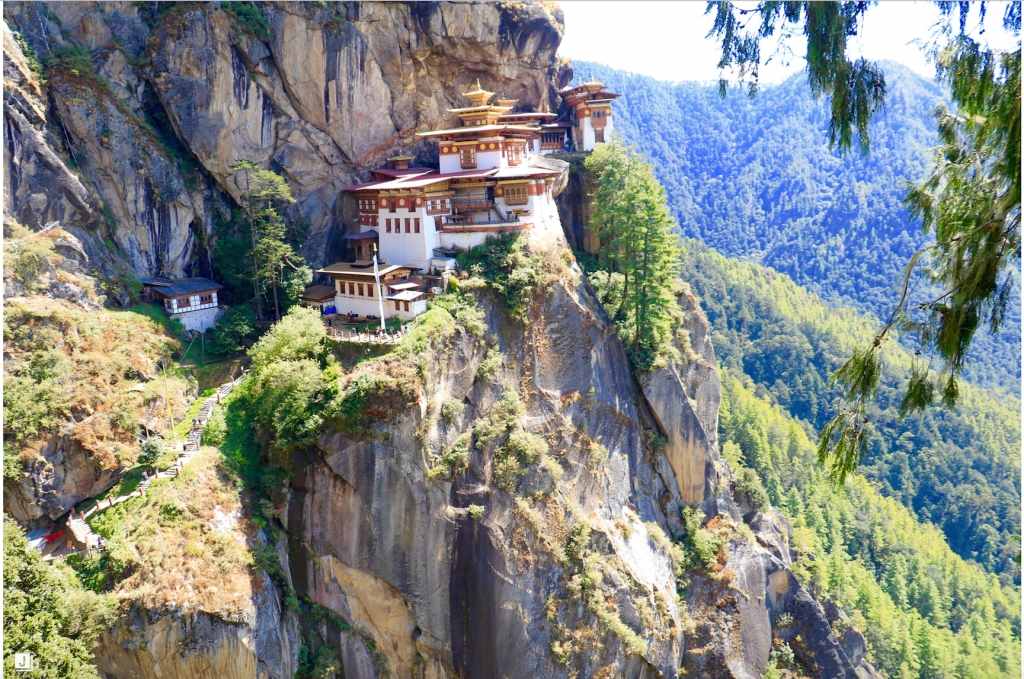
He came to that location on the back of a flying tigress. After meditating for 3 years, Rinpoche worked to convert the Bhutan people to Buddhism.
Getting there also involves a two-hour hike, putting this spot a bit off the beaten path, but it’s so worth it. Knowing a little bit about what makes Tiger’s Nest so significant also helps. There are also paths for mule and pony treks; however these do not go all the way to the top. Prayer flags act as a guide toward the monastery, truly immersing you into the religious and spiritual essence of the mountain. You will also see prayer wheels and chortens (meditations places) along the path, giving you an excuse to rest and take pictures.
Tiger’s Nest is notable enough to earn a visit from royalty. In 2015, the Duke and Duchess of Cambridge, Prince William and Kate Middleton made the trek to the monastery while visiting Bhutan.
2. Punakha Dzong –Visit the Punakha Dzong in western Bhutan it’s often considered the most beautiful Dzong in the country, it is also the most important Dzong in Bhutanese history. The Dzong was built in 1637, Punakha was the capital of Bhutan from 1637 to 1907 and the first national assembly was hosted here in 1953. It is the second oldest and second largest dzong in all of Bhutan and one of the most majestic and famous structures in the country.
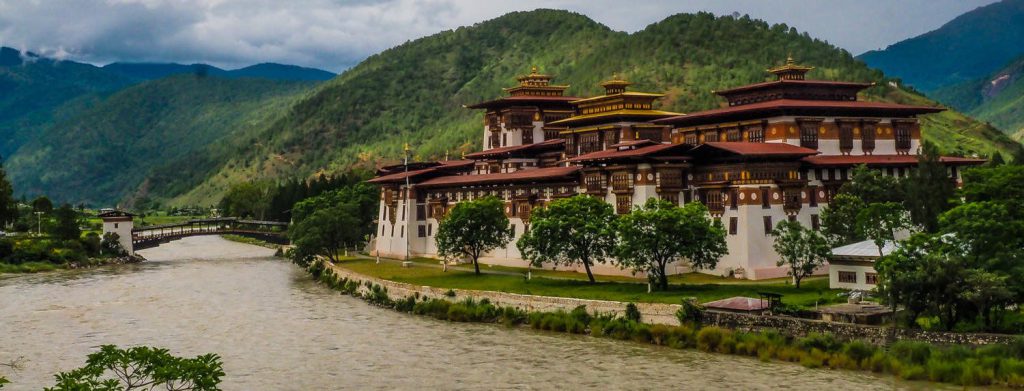
Punakha Dzong is perhaps the most beautiful dzong in the country, especially in spring when the lilac-coloured jacaranda trees bring a lush sensuality to the dzong’s characteristically towering whitewashed walls. It was the second dzong built in the kingdom as its capital. Later in the 1950’s, Thimphu became the country’s capital city. The Punakha Dzong rests on the edge of the convergence of the Mo Chhu and Pho Chhu Rivers. It took only about a year to finish the building of this Dzong, but by far the most impressive thing about this Dzong is that it was built without the use of nails, not even one. The dzong is still the winter residence of the dratshang (official monk body).
Most of Bhutan’s national treasures are kept inside this Dzong and it was here that the King of Bhutan His Majesty King Jigme Khesar Namgyel Wangchuck and his beautiful wife, the Queen of Bhutan Jetsun Pema got married in October 2011.
3. Festivals/Tshechu – Attend the Traditional Festivals – Tschechus are one and only common festival celebrated in all the districts in Bhutan as religious festival honoring Guru Rinpoche. Families gather to receive blessings and enjoy masked dancers as well as other performers that entertain the crowd. The festivals are held in several dzongs and goembas (fortress) throughout the year.
The Tshechu is mainly a religious event celebrated on tenth day of a month of lunar calendar corresponding to the birthday of Guru Rinpoche (Guru Padmasambhava). However the month of Tshechu depends from place to place and temple to temple.
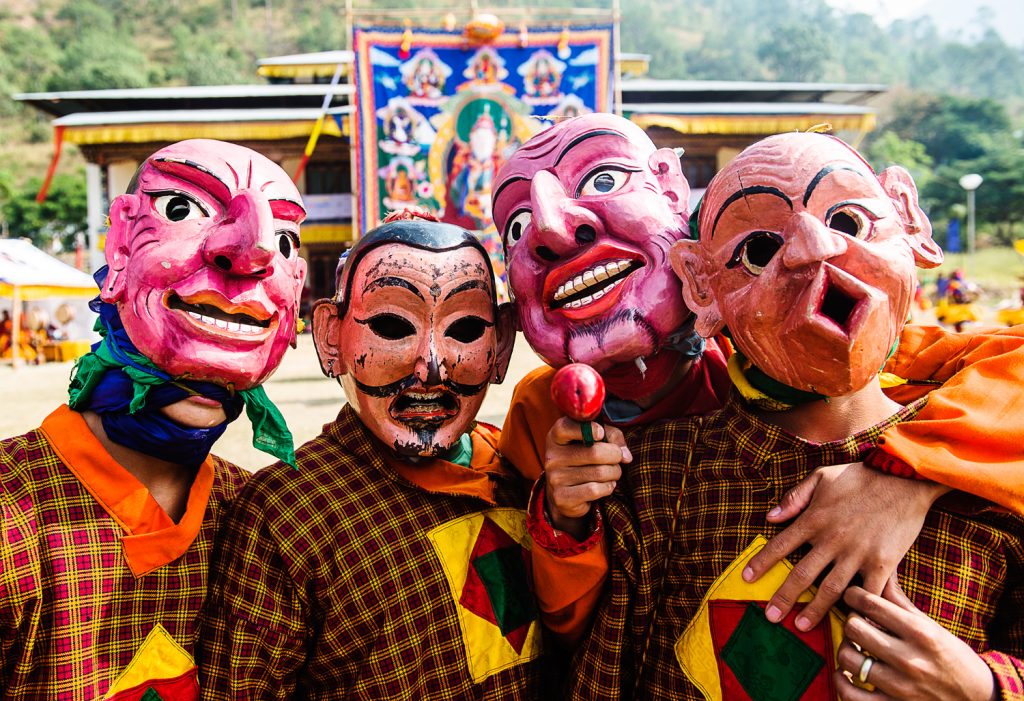
Tshechus are large social gatherings where people from various villages come together to witness the religious mask dances which are based on incidents from as long as 8th century from the life of Guru Padmasambhava and to receive blessings from lamas. The event also consists of colorful Bhutanese dances and other entertainments. The dances are known as Chaam and are performed to bless onlookers, to teach them the Buddhist dharma, to protect them from misfortune and to exorcise all evil, the dancers who take on the aspects of wrathful and compassionate deities, heroes, demons and animals do this. Shabdrung Nawang Namgyel and Pema Lingpa were main figures who composed many of the dances. It is believed that merit is gained by attending these religious festivals.
The dances invoke the deities to wipe out misfortunes, increase luck and general personal wishes. Onlookers rarely fail to notice the Atsara or clowns who move through the crowds, mimicking the dancers and performing comic routines in their masks with the long red noses. A group of ladies perform traditional Bhutanese dances during the intervals between masked dances.
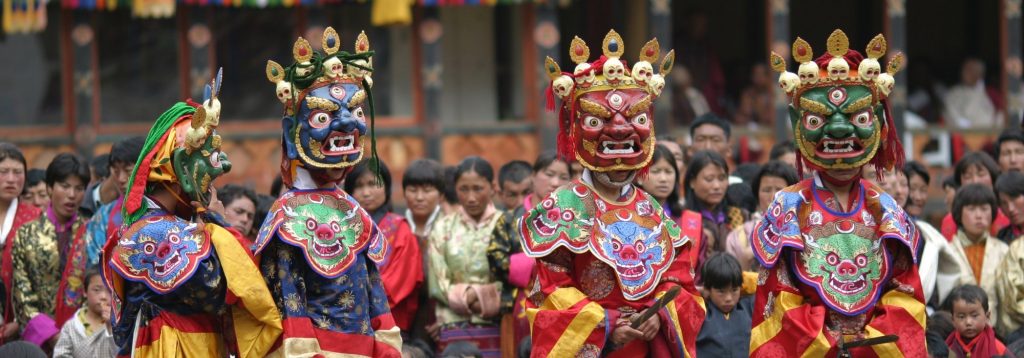
An auspicious event of the many of the Tshechus is the in furling of the Thongdrel from the building overlooking the dance area. This is done before sunrise and most people rush to witness the moment. Thongdrols are large Thangkas or religious pictures that are usually embroidered rather than painted. The word itself means, “Liberation on sight”. It is believed that sins are wiped away simply by viewing it.
Every mask dances performed during Tshechu has a meaning or a story behind. In monasteries monks perform the mask dances and in remote villages monks and village men perform them jointly. Besides the locals many tourists from across the world are attracted to this unique, colorful and exciting culture.
4. Nature at its Best – Breathe fresh and Live healthy. Nature seems to have a privileged grace and courtesy on the kingdom of Bhutan. The majestic hill stations, innumerable varieties of flora and fauna and heavenly water bodies surrounding with the scenic beauty make Bhutan a paradise for the residents as well as the tourists. People there make sure that their natural ecosystems are well preserved and maintained.
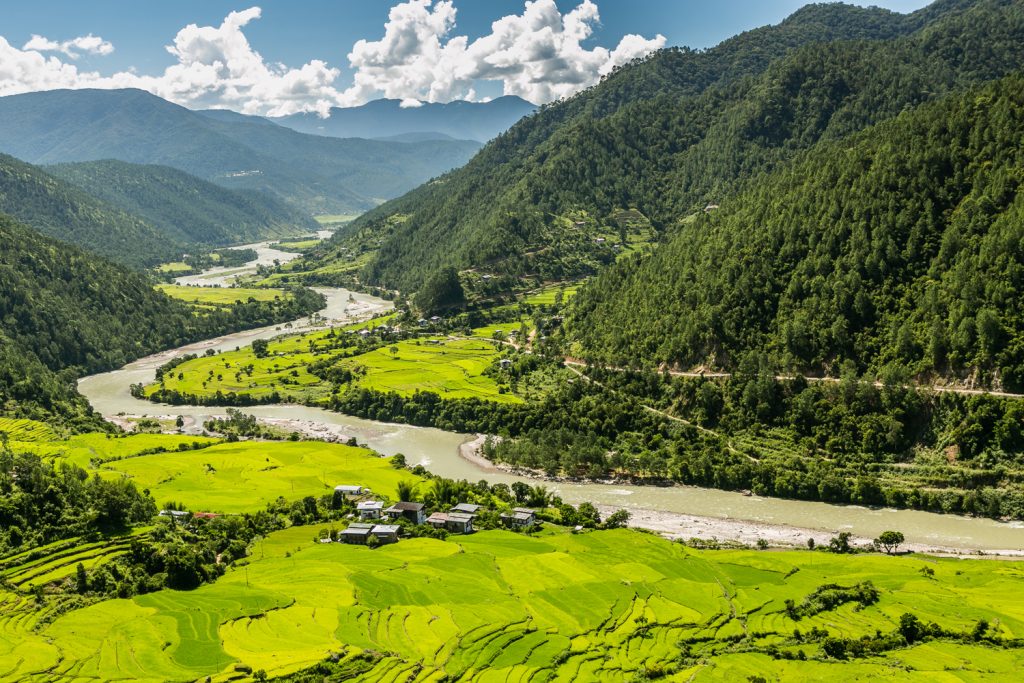
5. Bumthang
Valley – Bumthang Dzongkhag is a massive
region that is made up of the Choekhor, Tang, Chhume, and the Ura Valleys.
Choekhor Valley is the largest of the region as is considered the Bumthang
Valley. This peaceful valley is filled with apple orchards, dairy farms, potato
patches, and rice and buckwheat fields.
The first Swiss cheese making facility in Bhutan began in Bumthang. The factory
is also a brewery that houses the best beer in Bhutan named the Red Panda. Beekeeping is also increasingly becoming popular among
the farmers of Bumthang. Guests can tour the brewery and cheese factory
during specified hours. This dzongkhag is one of
the most richly endowed districts in terms of historical and spiritual legacy.
Some of Bhutan’s oldest and most venerated temples are found in Bumthang,
including Jambey Lhakhang. According to legend the Tibetan king Songtsen Gampo
in 659 A.D. as part of a chain of 108 simultaneously constructed temples in
order to subdue an evil demoness that lay over the Himalayan region built this
ancient temple. It is the oldest Lhakhang in Bhutan. There are numerous other
temples and shrines worth visiting in Bumthang and many of them are linked to
Guru Rinpoche’s visit in 746 A.D.
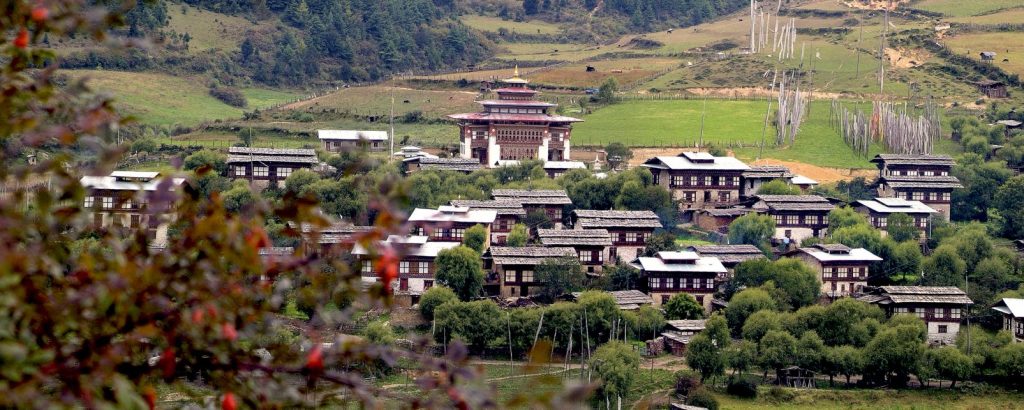
The fertile valleys of Bumthang are covered in fields of buckwheat, rice and potatoes. Apple orchards and dairy farms are also common sights here. This serene region is one of the most peaceful places in the kingdom.
7. High End Hotels – Luxury Accommodation – Accommodation in Bhutan tends to be either high-end or homely; both provide a great insight into this intriguing country. You’ll have a wonderful time at one of these 5-star hotels. Spa treatments, delicious meals, and attentive guest service are all ready for you. You’re sure to find exactly the accommodation you need. You’ll also enjoy a high standard of care and meticulous guest relations, so get ready for a wonderful adventure. What kind of amenities will make your stay a wonderful one? Various massage, yoga, hot stone spas help your cares fall away? A concierge to help you plan every detail of your day? Plush carpeting, delectable chocolate desserts, and even spectacular views…these hotels will astonish you.
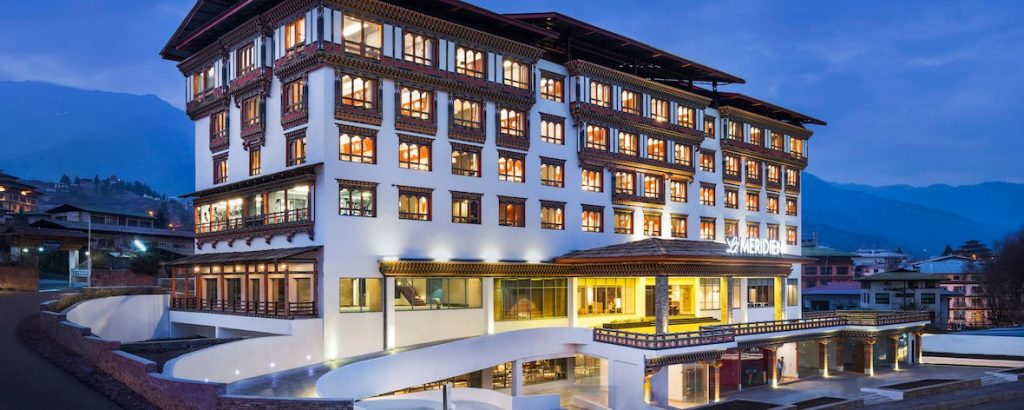
8. Black-Necked Crane – Explore habitat – The crane is a wildlife creature that comes to the Phobjikha Valley every winter. It is an endangered species and is celebrated by the Bhutanese annually with the Black-Necked Crane Festival. This 9-day event is intended to bring awareness to the bird’s importance. The Crane Festival is held on the King’s birthday, November 11th of every year.
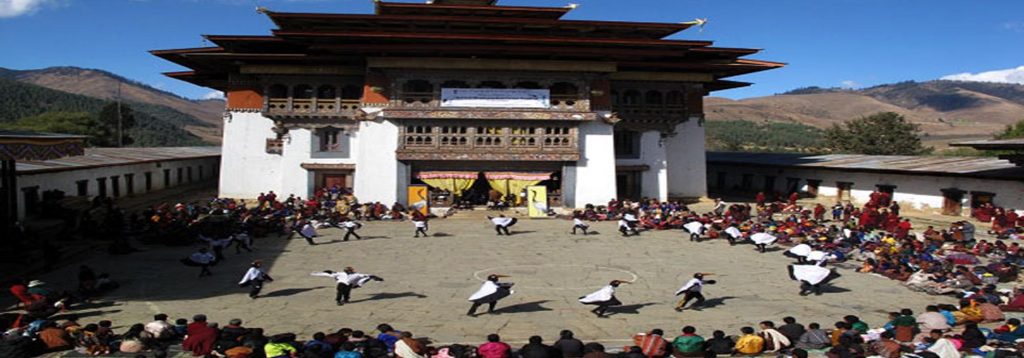
9. Traditional Textiles – The Art of Bhutanese weaving – Bhutan, textiles are considered to be one of the highest form of art and spiritual expression. The knowledge and skills required to create these textiles have been passed down through generations. By utilizing primarily the simple back strap loom, the Thunder Dragon People have crafted one of the most advanced and sophisticated weaving cultures in the history of civilization. Traditional textiles are generally created by Bhutanese women. The material is hand-woven and dyed with intricate patterns making each garment unique. The National Textile Museum is in Thimphu.
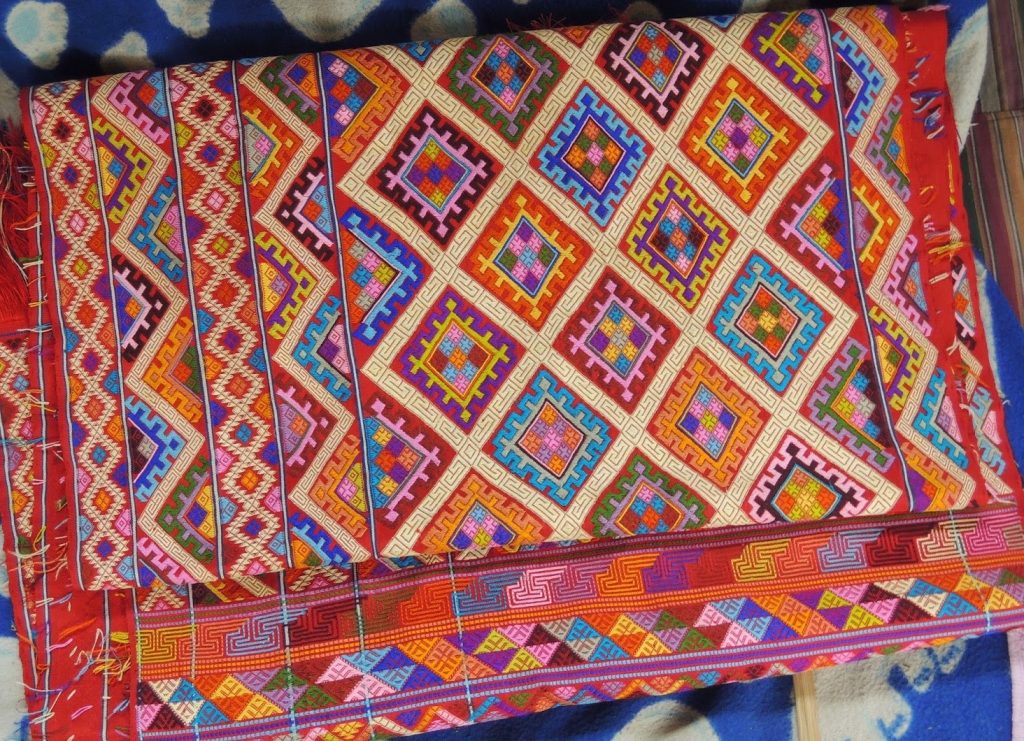
10. Chimmi Lhakhang – Visit the Temple of the Divine Madman – One ofthe most honoured temples in Bhutan, the Temple of Fertility or the Chimi Lhakhang is dedicated to the ‘Divine Madman’, Lama Drukpa Kunley. Frequented by tourists and childless couples seeking special blessings to beget a child. The temple is decorated with colourful phalluses that are believed to drive malicious gossip and evil eye away. Does being hit on the head by a wooden penis sound like ablessing to you? Well it is in Bhutan! The Temple of The Divine Madman (yes really) is a pilgrimage site for childless couples who are blessed in the temple in the hope of becoming fertile. I wasn’t 100% aware of this at the time the monk was performing the blessing on me, and listened in horror as I was afterwards told that I would most likely now fall pregnant. And who is the Divine Madman you may ask? Drupa Kunley was a monk who wanted to show that it is possible to become enlightened without giving up on earthly pleasures, so his methods included “blessing” women with sex (again, yes really).
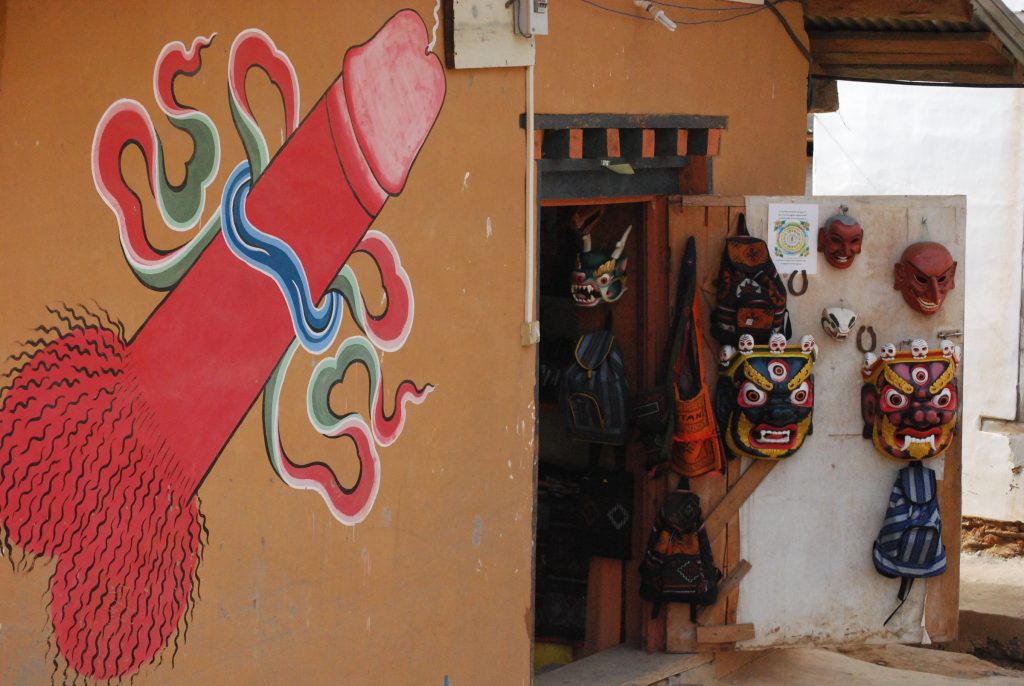
Because of this, Bhutan is full of phallic images painted onto houses, hanging outside the doorways, even placed on the dinner table in the place of a flower bouquet. Phallic images are said to ward off evil spirits and are the subject of intense devotion in Bhutan. After a while you even get used to looking at them as you try to eat your way through some fiery ‘ema datshi’ (the national dish). Oh, by the way Drupa Kunley’s own penis is referred to as the “Thunderbolt of Flaming Wisdom”!
12. Cuisine – A Bhutanese Kitchen – The Himalayan Kingdom of Bhutan is a world unto itself, and the food from the country is a strong part of that world. Though Bhutan serves a variety of cuisines–such as Indian, Tibetan, Nepali and Chinese–for travelers seeking somewhat familiar tastes, the country’s own food is as delicious as it is distinct, offering the curious and hungry a meal to remember.
Unpolishedred rice (or brown rice as some people know it) with dishes of vegetables, chilies and meat are staples of the typical Bhutanese meal. It sounds simple enough, yet its striking flavors render this cuisine remarkable.
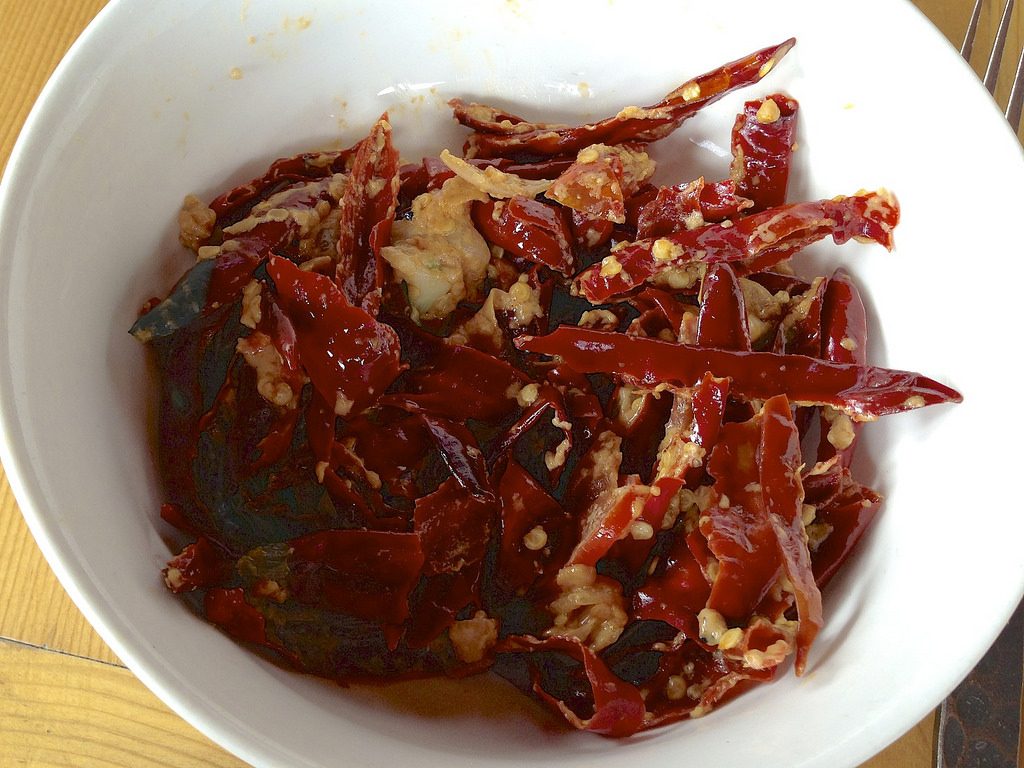
Chilies–green or red and dry or fresh–are added to dishes to make for some hearty flavors, but this is not their only function. Chilies in Bhutan aren’t merely additions to a dish; in several cases, they are the main ingredients itself.
Ema Datshi, a dish consisting of cheese and chili, is considered to be the national dish of Bhutan. Though the dish is commonly found across Bhutan, its taste can vary. Expect some variations with this dish. Some people prepare the dish with a creamy consistency, while others make this a broth-style cheese dish. Though chilies are the main vegetable on this dish, it is not intolerably spicy. The seeds of the chilies are removed before they are added to the gravy, and most restaurants do prepare the dish with tourists’ chili-sensitivity in mind.
Bhutanese cuisine caters very well to meat eaters, with pork and beef commonly available, along with chicken. Some of the classic meat dishes of Bhutan use pork as a main ingredient. There are a number of dishes made with a dried variant of beef known as Shakam, which is another highly recommended form of meat to try. Shakam Paa is one such commonly found beef dish. It is made with dried chilies and a vegetable or two, such as radish.
A meat that can be called a Bhutanese staple is yak, which is also prepared in similar ways to beef. Those who prefer eating chicken can also find a few.
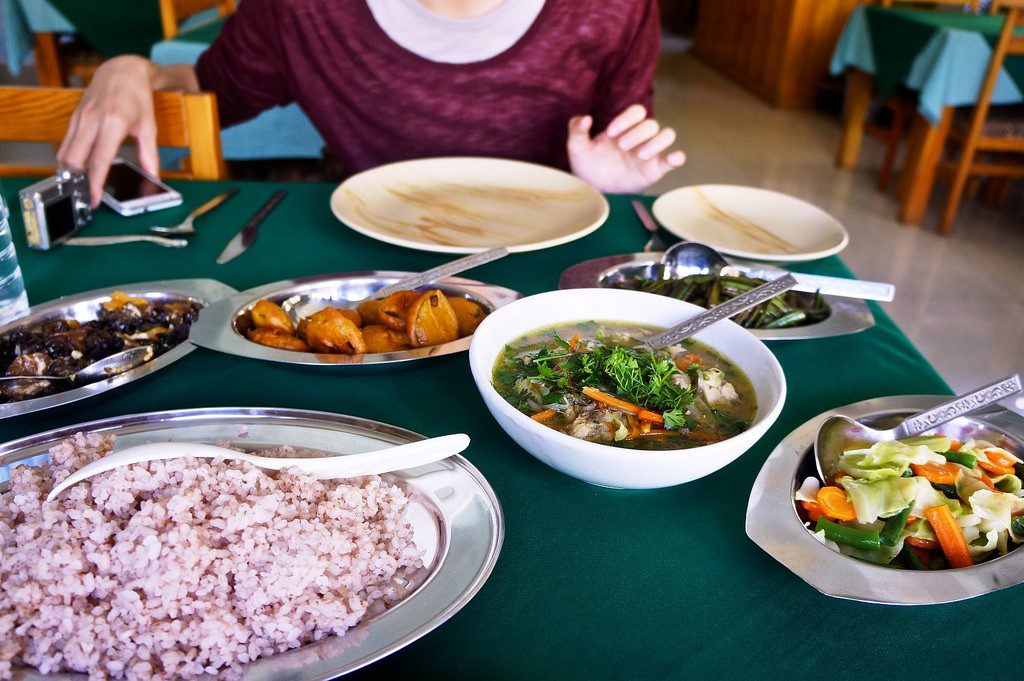
For vegetarians, Bhutanese cuisine can be as exciting it is for non-vegetarians. The delicious Ema Datsi comes in different versions wherein vegetables are added to the mix. Expect to find Shamu Datsi with mushrooms, Kewa Datsi with potatoes and many other styles with spinach, asparagus and other such ingredients added. There are also leafy vegetables available, sometimes cooked in a soup-like form known as Jaju.
Architectures – Jaw-dropping architectures – Since the 17th century, Bhutanese architecture is one of the most striking features of the country. Massive dzongs (fort-monasteries), remote goembas (monasteries) and lhakhangs (temples), as well as the traditional houses all subscribe to a characteristic Bhutanese style. Dzongs have been big deals in Bhutan.
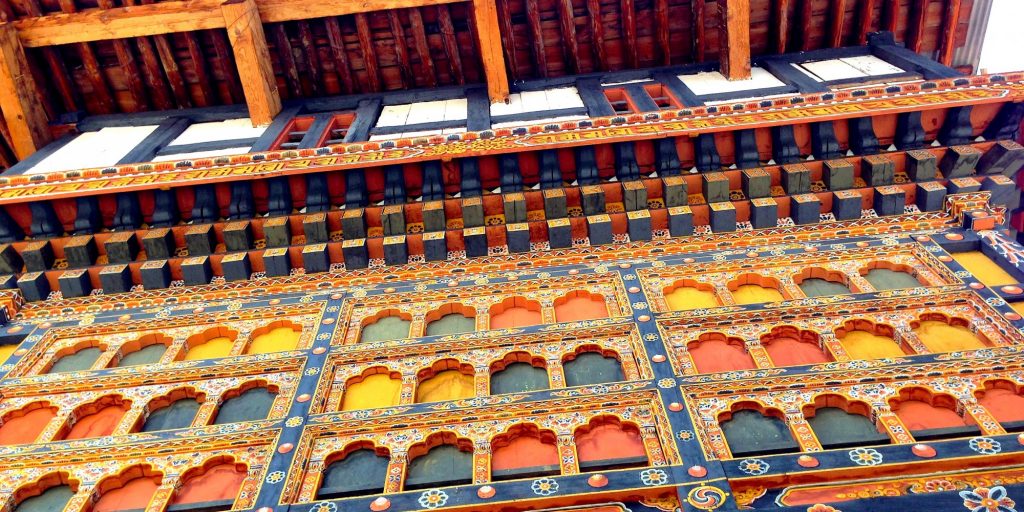
They refer to governmental administrative offices that also act as Buddhist shrines for the people. The intricate designs throughout the country are specifically Bhutanese: multi-colored wood frontages, small arched windows, and a sloping roof.
Home Stay; Experience a Home/Farm Stays – One of the unique ways to share the life of local people and experience traditional life in the countryside is spending a few days on a Bhutanese farm. Getting bad service at a hotel in Bhutan isn’t really that common. With friendly resorts instead of stiff, high-class chains and a personalized experience that seriously trumps any readymade hotel destination, this is a great place to visit. Locals, making them much more have a fun and cultural experience, run the hotels and resorts.
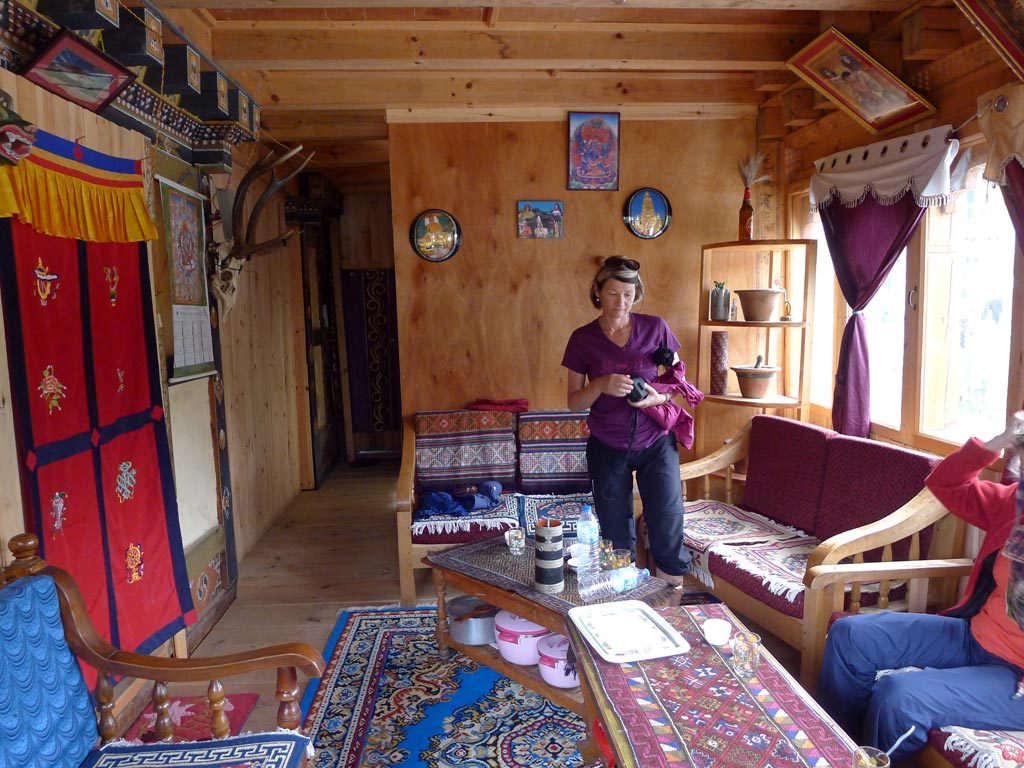
Buddhism – Main Religion – Buddhism is ingrained into Bhutan’s landscape and daily life, with prayer flags, prayer wheels and white chortens. A basic understanding of Buddhism really does add to the experience of travelling through Bhutan, and helps one to really appreciate the complex visual tapestries that are found throughout the country.
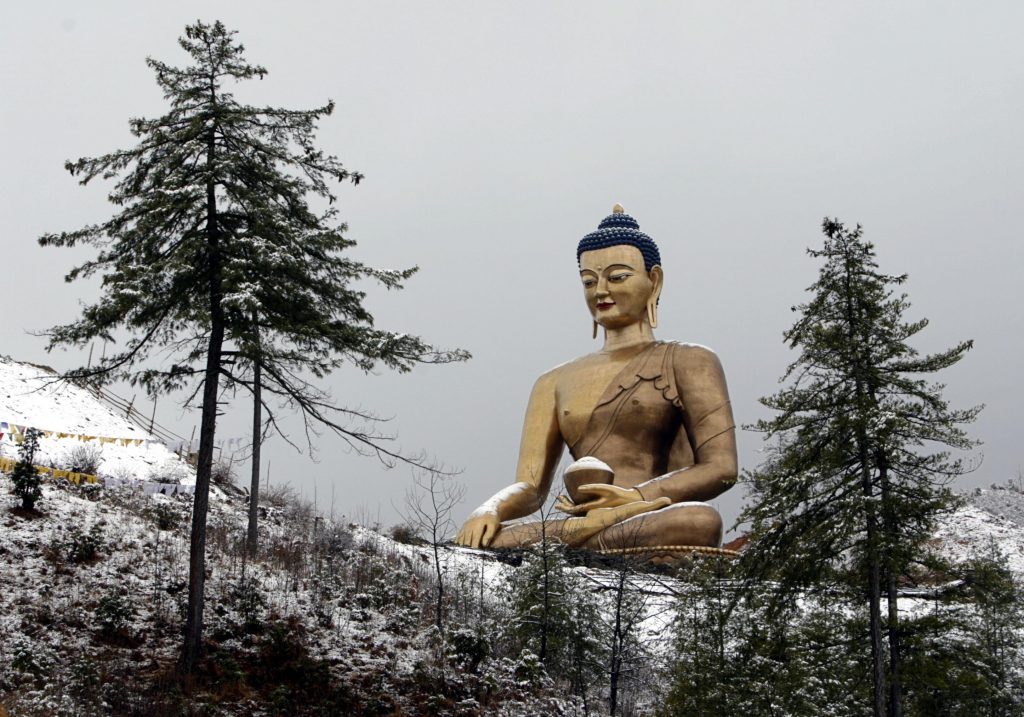
Mahayana Buddhism is the state religion of Bhutan, and Buddhists comprise two-thirds to three-quarters of its population.
OUTDOORS ADVENTURES
Unique adventure unlike no other
Bhutan is swiftly developing its reputation as a premier destination for adventure sports. There is a lot to do in Bhutan and no limited amount of outdoor activities. Whether you want to commit to an overnight trek, explore river rafting, or tee off on a relaxing golf course, your tour advisors can help to provide you with an appropriate itinerary. All the necessary arrangements for adventure activities can be made through Get Into Bhutan Tour operator. They will provide you with well-trained and experienced guides to ensure your safety at all times.
Golfing – The Royal Thimphu Golf Club, located in the capital city of Thimphu, is a 9-hole course. It has a direct view of the Trashi Chhoe Dzong, the King’s palace. This golf course is the only one that is open to the public.
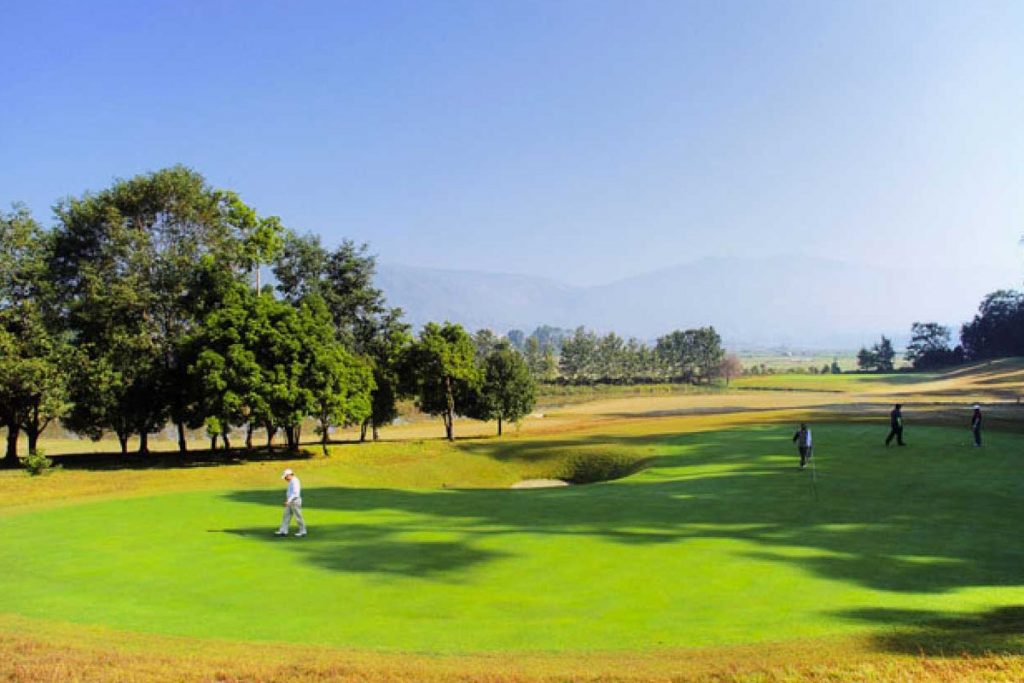
Biking – Wheel on the Road – Bhutan lends itself well to both on-road or off-road mountain biking and the sport is seeing increasing popularity among both visitors and
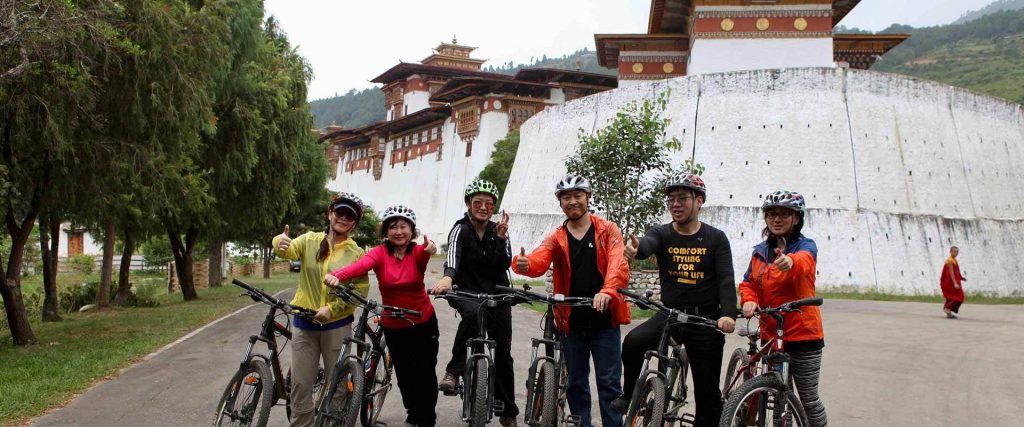
Bhutanese alike. Some of the terrain may be more challenging as you enter the mountainous region. Biking in Bhutan can take you through towns and small villages where you can experience the Bhutanese culture. Biking is now becoming a very unique and original way of seeing and interacting with the country, people and the Bhutanese environment.
River Rafting and Kayaking – The crystal clear rivers of Bhutan are one of the kingdom’s best-kept open secrets. Fed by the glacial-melt of the Eastern Himalayas. Rafting and kayaking tours take place on 6 major rivers. Adventurous travelers will not be disappointed by the rugged, untamed waterways of Bhutan.
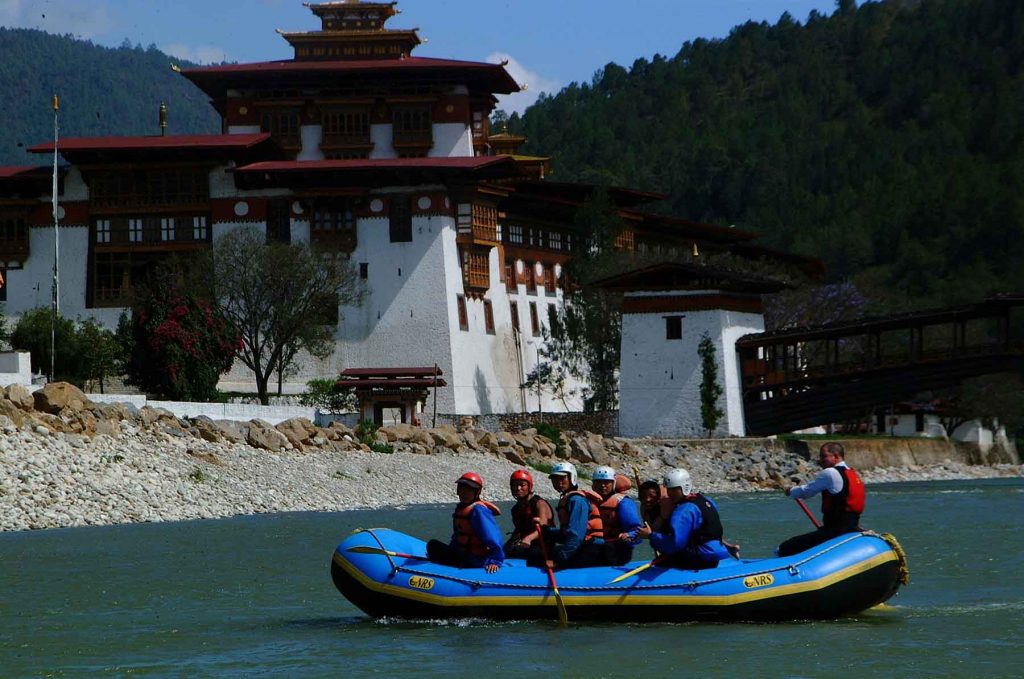
Rivers are plentiful with strong currents varying between slow, gentle flows in some places and powerful, raging torrents can be found throughout the country. Some currents can be somewhat rough, while others are smooth. During these trips, you will be able to see natural wildlife, ancient temples, and unique landscapes.
Watch (or Learn) Archery – National Game of a Country – Archery is Bhutan’s national sport and is practised everywhere in the country. From local tournaments between friends to national competitions, the activity is taken rather seriously. Traditionally, members of the opposing team make fun of each archer so as to confuse the contestant whilst members of the same team celebrate each successful shot. Once you understand what is going on, the spectacle provides some great fun and entertainment!
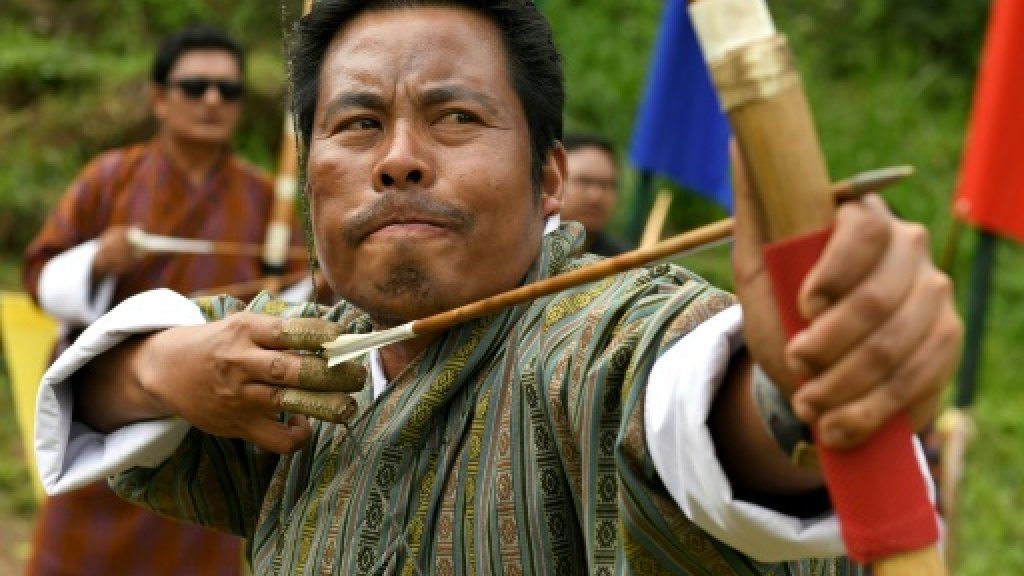
FITTING IN LIKE A LOCAL
1. Wear a gho, for a man or kira, for a woman. They are traditional Bhutan garments. You can grab one and wear it and be in Bhutanese attire at one of the festivals. If any of the tourists wish to experience Bhutanese dress to shoot picture it will be available to experience.
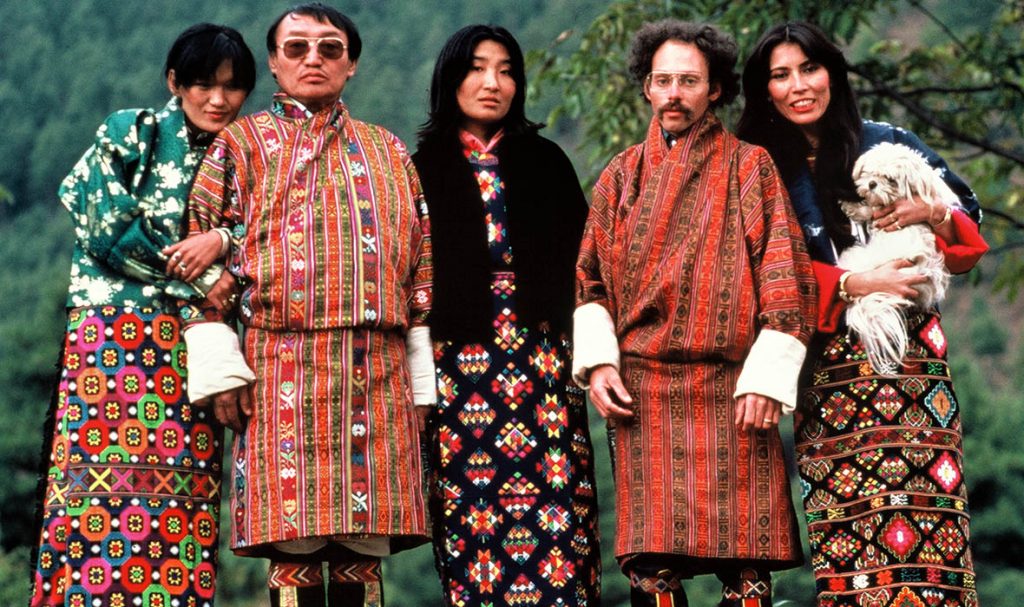
2. When visiting Bhutan, hang some prayer flags along places of spiritual importance to bless the surroundings.
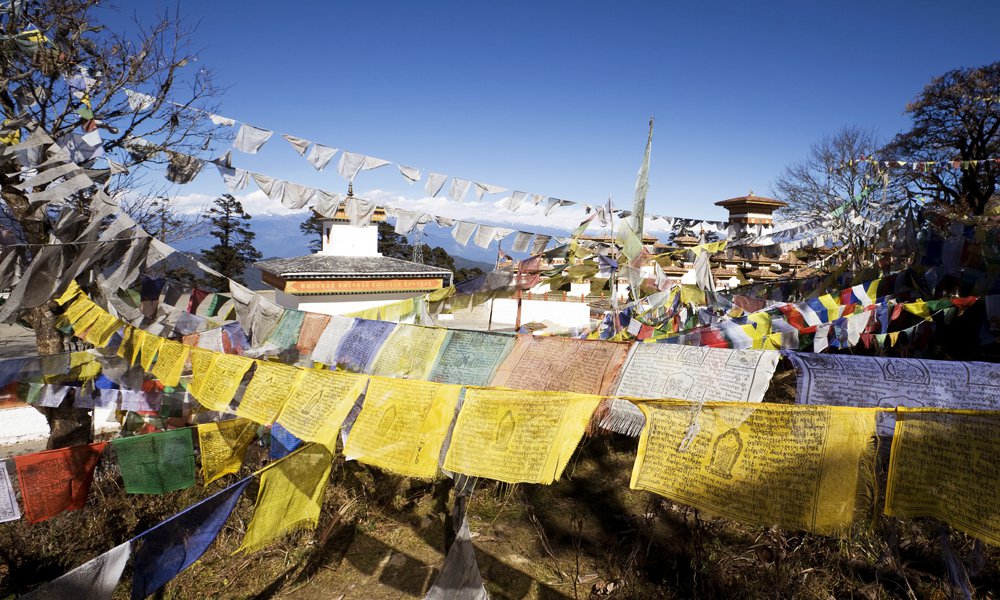
3. See what it is like to stay with a large Bhutanese family overnight. Get Into Bhutan can arrange for an overnight stay at a local farmhouse.

4. Try traditional snacks and cuisines. Grab a quick snack of yak cheese or a silver of jellied cow skin. Have a delightful Burger made with yak patties and Bumthang Gouda cheese for dinner.
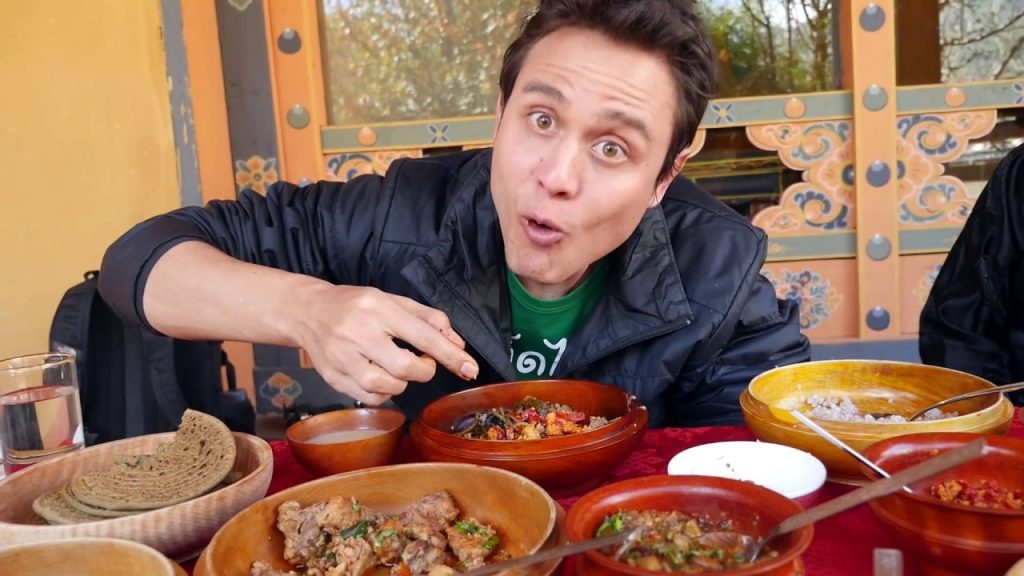
BHUTAN’S KING AND QUEEN
His Majesty, the King Jigme Khesar Namgyel Wangchuck was extremely popular even before he married a commoner, Jetsun Pema. His family line has welcomed the throne for the past 100 years. He is the fifth ruler in his family to take possession on the crown. Bhutanese admire and love the royal family.
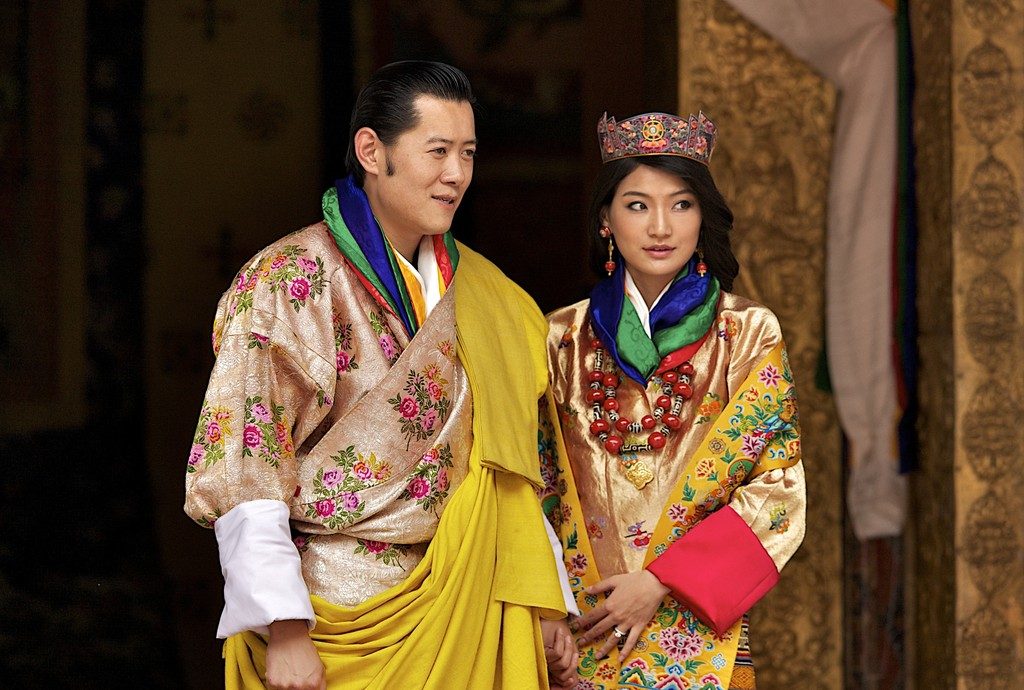
NATIONAL FLOWER
The national flower of Bhutan is the Himalayan Blue Poppy or Euitgel Metog Hoem. This unique flower grows above tree level on rocky mountain regions.
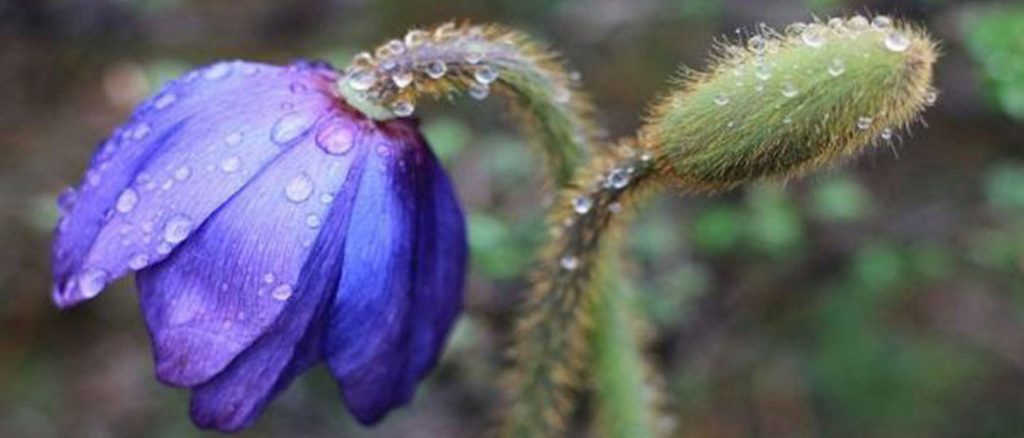
STATE RELIGION
The official religion is Vajrayana Buddhism. Bhutan is the last kingdom to practice Vajrayana Buddhism. The teachings allow one to embody both mind and body. You will reach enlightenment if you follow and understand the concepts of emptiness, wisdom, compassion, and skillful means.
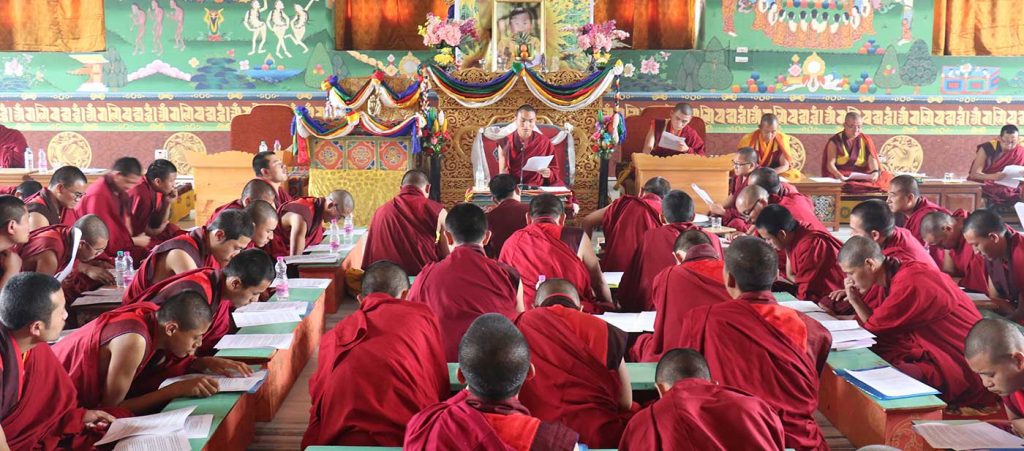
NATIONALANIMAL
The Takin, or gnu goat is Bhutan’s national animal. It lives in forested areas in mountain areas of 4,000-meter altitudes and above. Takin have a stocky body on short legs with two-toed hoofed feet. It has a long nose and stout horns. These animals feed on bamboo, grass, leaves, and other plants. Takin are rare, and endangered species.
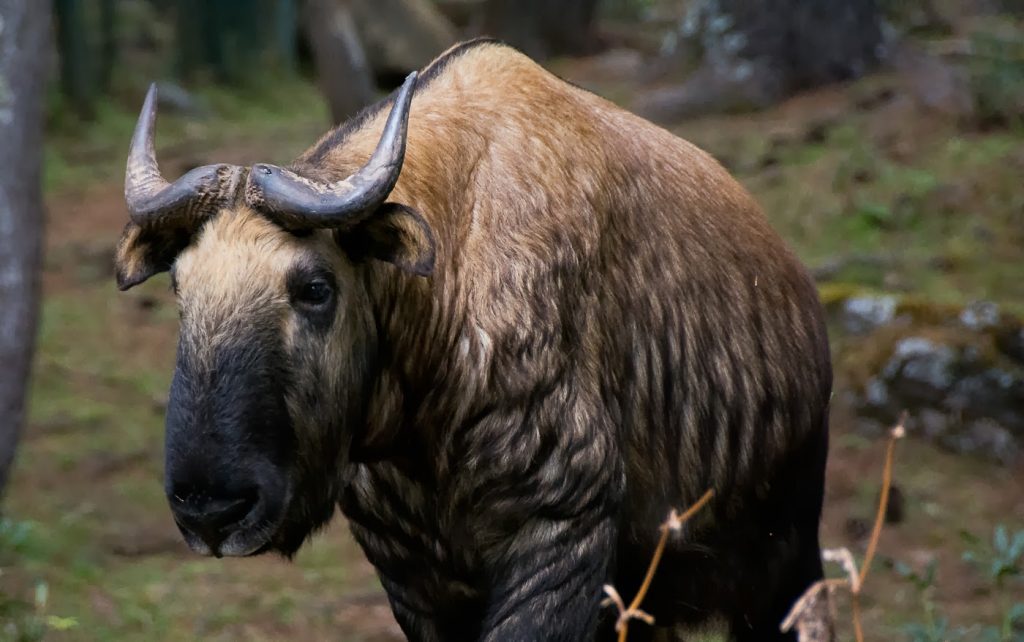
NATIONAL SPORTS
Archery became Bhutan’s national sport in 1971. Although only men were allowed to play during festivals, tournaments, and religious celebrations, female archer can enter into the Summer Olympic Games.
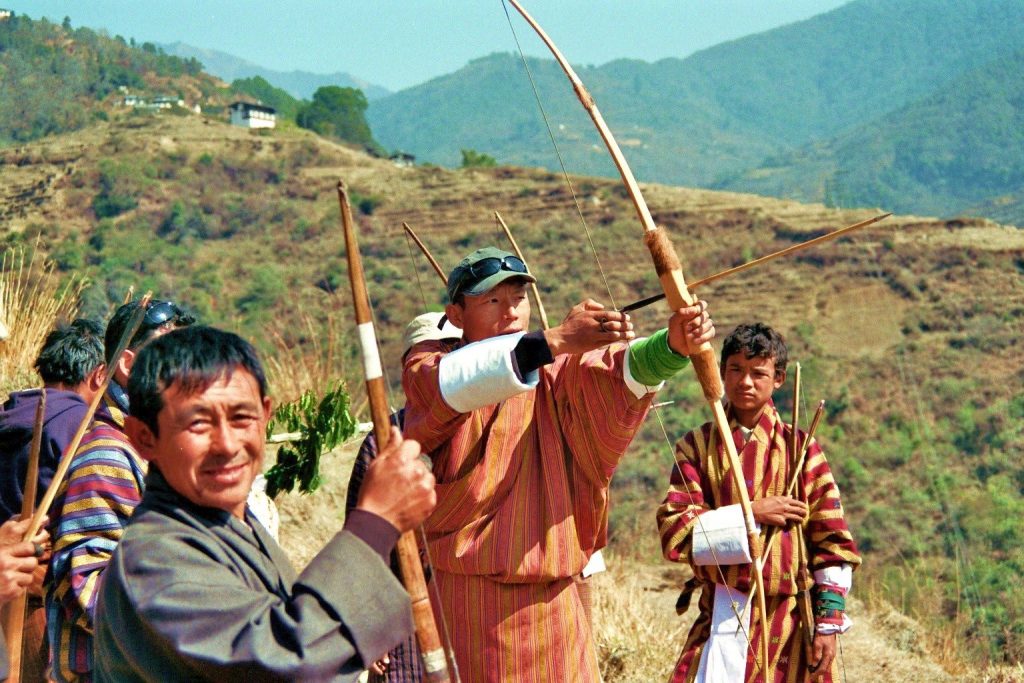
BHUTAN LANGUAGE
The official language in Bhutan is Dzongkha. Bhutanese also speak Tshanglakha and the Lhotshamkha. Tshanglakha is spoken in the western region of the country and the southern Bhutanese uses Lhotshamkha. There are at least 19 dialects of Dzongkha that are spoken all over Bhutan. Most of the people that are in the tourism industry speak English. It is also being taught in schools.

BHUTAN CURRENCY
Ngultrum (Nu) is Bhutan’s currency. Until the 1960’s, Bhutanese bartered goods and services because there was no paper money. Today, in addition to ngultrum, you can use Indian rupees at different shops and restaurants around the country.
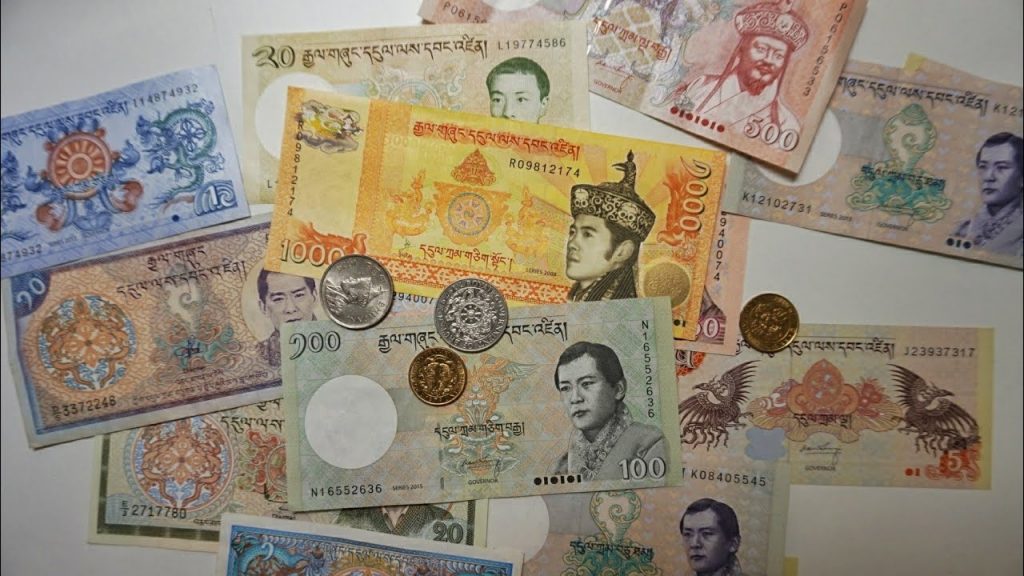
WEATHER AND TEMPERATURE OF BHUTAN
The climate changes with the elevation. Because there are mountainous regions as well as plains and valleys, the temperature can range from subtropical to arctic. Spring, summer, autumn, and winter are the four seasons in Bhutan. It snows most of the year in the northern area. The southern region of Bhutan has a year-round subtropical atmosphere. The central region is cool with dry winters. Eastern Bhutan is dry and warm while the west has heavy Indian monsoon rains that last between June and September.
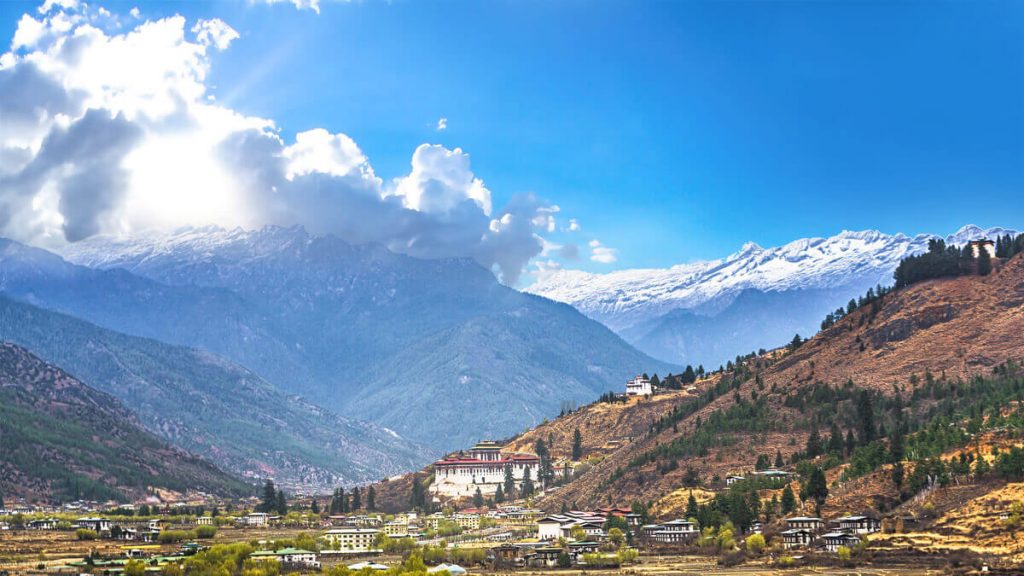
CULTURE AND COSTUME
For generations the Kingdom of Bhutan has isolated its culture and society from outside influences. This drive is to insure the protection of ancient teachings. Today, these teachings are passed on through festivals and other events that tell stories of their ancestry. Bhutanese dress in festive costumes, some with masks and created detailed recreations and dances that entertain and bestow onto others the Bhutanese spiritual life story.
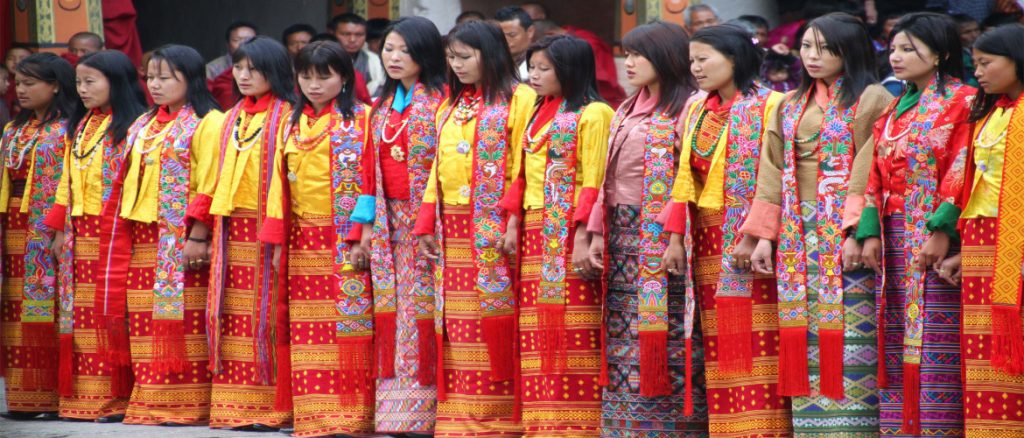
BUDDHIST PAINTING
Buddhist paintings are found in dzongs, goembas, and lhakhangs. The hand-painted murals tell stories that deliver messages of peace and harmony. One example is the Thuenpa Puen Shi (Four Friends) mural depicts the harmonious efforts between a monkey, peacock, elephant, and a rabbit. The four decided to work together to grow fruit that they all wanted to eat. Each had a job and through cooperation and harmony, they were able to reach the fruit after it had grown into a tree.
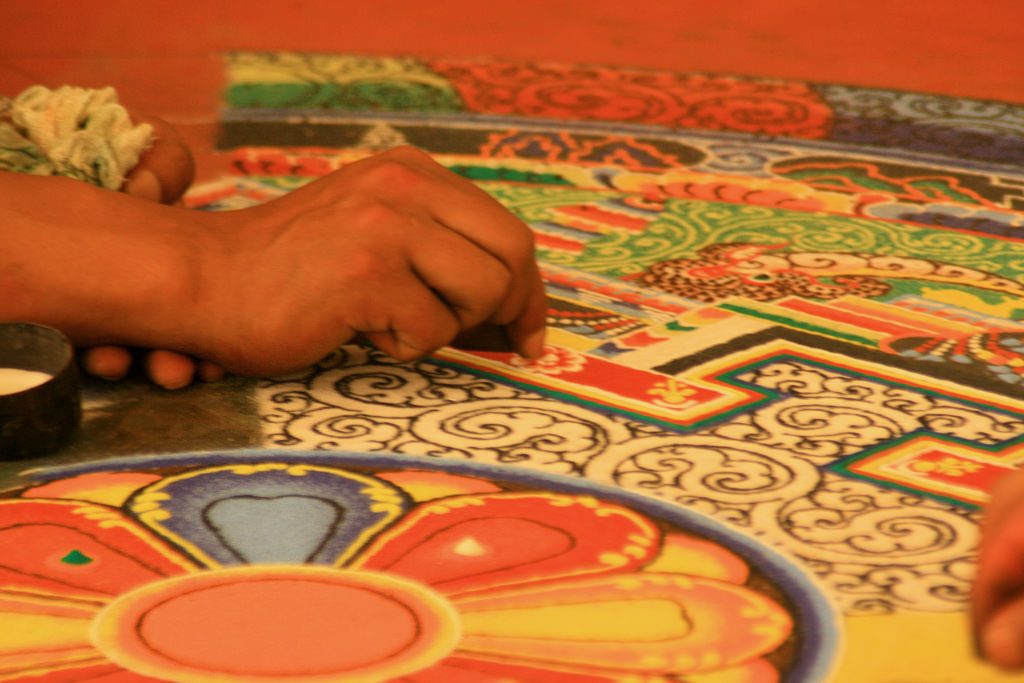
PRAYER WHEEL
A prayer wheel is a cylindrical wheel with a hand carved mantra on the outside, Om Mani Padme Hum, and printed prayers on the inside. They are usually made of wood, stone, brass, tin, or coarse cotton. Spinning the wheel clockwise will release the prayers into the world and purify negative energies. It also releases blessings and wishes. Prayer wheels can be spun by hand, water, or fire. Water powered prayer wheels blesses the water as it touches the wheel. Those prayers flow to rivers, lakes, and oceans. Heat emanating from a lit candle or electric light spins fire prayer wheels. The light passes its blessings to everyone it touches.
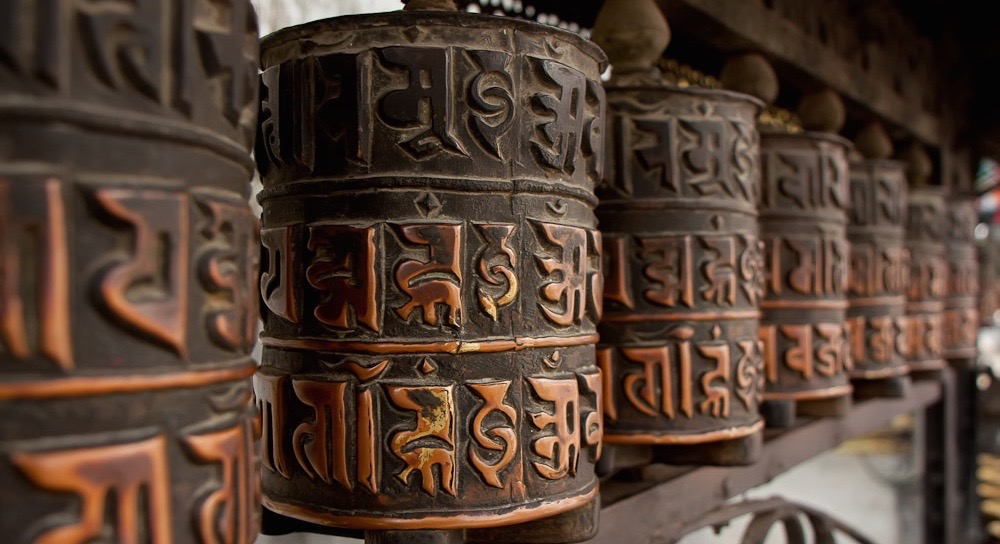
WILDLIFE & SANCTUARIES
70% of Bhutan Land Mass is considered Sanctuaries
There is a diverse amount of flora and fauna in the Kingdom of Bhutan. Because of the varying temperatures, creatures enjoy the subtropical and arctic climates.
Although there are some rare animals in the National Park, trekking through the mountainous regions will give a glimpse of a variety of wildlife animals, like the blue sheep. The blue sheep is a cross between a goat and a sheep. It has a bluish hue during the winter months and can be viewed between 1800-4300 meters. Yaks, wolves, musk deer, fat marmots, and takins also love the high atmospheric temperatures.
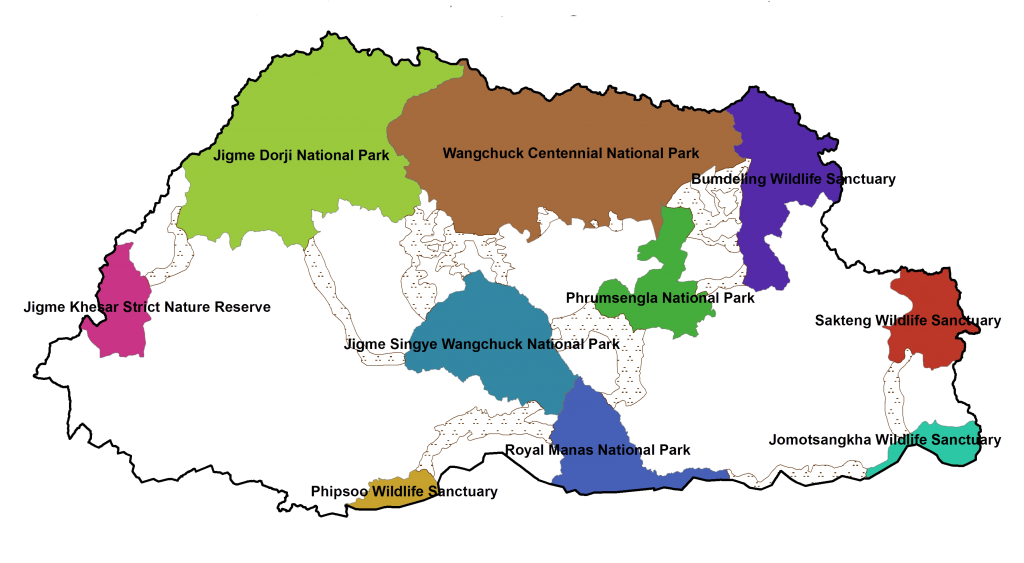
Bhutan is home to 3 species of langurs and 600 species of birds. Langurs are monkeys with both gray or golden-brown fur and interesting black faces. The birds migrate to the wondrous and peaceful Bhutan country at different times of the year. The raven is the national bird. It represents one of the Bhutan deities, Gonpo Jarodongchen. The protected black-necked crane another bird that is revered by the people.
Over 50% of the country protects its wildlife. Whether in national parks or wildlife preserves, the conservation efforts exist to maintain the animals’ life and culture.
BHUTAN ARCHITECTURE
Bhutan is filled with stunning architectural building, such as dzongs, goembas, and lhakhangs. Dzongs primary function, beginning in the 17th century, was as a fortress. Today the buildings are used as administrative offices for each of the 20 dzongkhas (districts) in Bhutan. Dzongs are made of stone or pounded mud and timber with wooden shingled roofs. Even though fires caused many of the dzongs to be rebuilt, reconstruction method are consistently traditional with the exception of iron roofs instead of wooden.
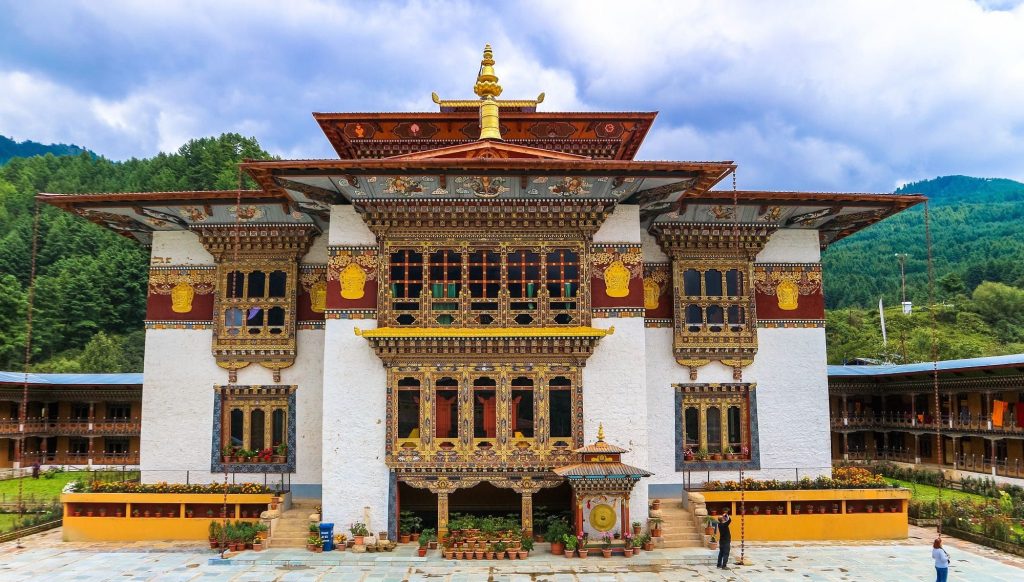
Goembas are monasteries. Each goemba contains an autonomous community complete with a temples and a dormitory. Goembas have a khemar just beneath the roof, in fact all religious buildings in Bhutan have this large red stripe. Brass plates are placed on the khemar to represent the sun. Goembas often have painted murals that depict the Wheel of Life, the Six Symbols of Longevity, and the Guardians of the Four Directions. A geometric poem on a small quilt is dedicated to Zhabdrung is often at the entrance of goembas.
Lhakhang have yellow roofs with a bell-shaped ornament painted in gold on the top. Similar to goembas the entrances of Lhakhang have painted murals depicting with the Guardians of the Four Directions or the Wheel of Life. People walk outside of the building in a clockwise direction and spin the prayer wheels located on the lower level outside of the lhakhang. After spinning the prayer wheels to release positive prayers, you will enter the temple into a great hall. The walls will be covered with astonishing Buddhist paintings with an altar that sits at the end of the hall. A statue of an ancient Buddhist figure, Guru Rinpoche or Jampa, dominates the area.
HISTORY OF BHUTAN
Founded in early 2000 B.C., Bhutan was known by many names. Some of the names included Lho Jong, Lho Mon Kha Shi, Lho Jong Men Jong, and more. During the 17th century, it became officially known as Druk Yul, the “Land of the Drukpas”. Drukpas referred to the religion of Buddhism that the people began to practice, which is now the dominant religion of the country. Previously in the 7th century, Bonism was the religion in Bhutan until the Tibetan King Songtsen Gampo and Guru Rinpoche introduced and taught the people the details of Buddhism.
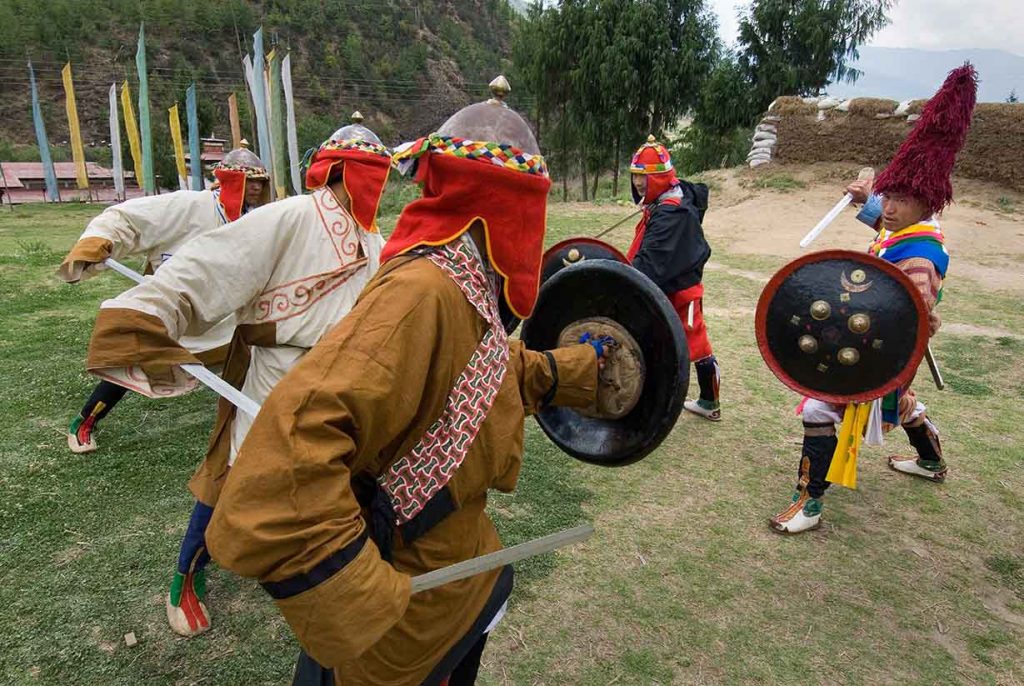
Ngawang Namyel, the first Zhabdrung, established his power after he arrived in 1616 A.D. He defeated several Tibetan armies and unified battling Bhutan tribes. He started a governing system that was followed until his death. The system broke down and infighting began. A new system of government began with the establishment of a monarchy. The first Druk Gyalpo, or Dragon King provided rules for Bhutan citizen to have a better way of life. In 1971, Bhutan officially became a participating member of the United Nations.
THE BHUTAN WAY OF LIFE
The isolate Himalayan country has preserved its culture and traditions for thousands of years. Bhutan still tries to preserve its culture even through the new modernization efforts and technological influences. Bhutanese practice Buddhism, the religion that was brought to them in the 7th century. While the majority of the country is Buddhist, the southern region practices Hinduism. The Bhutan people keep their religious traditions alive with festivals and other events that celebrate their history.
More than 60% of Bhutanese are farmers, breeding livestock and harvesting crops. These rural people are self-sustaining. They make their own clothing, food, decorations, and bedding. Only small amounts of people live and work in urban areas. Most work in the service industries where they can be tour guides, teachers, army members, or police officials. Women are able to work in these industries, in addition to producing weaving for additional household income.
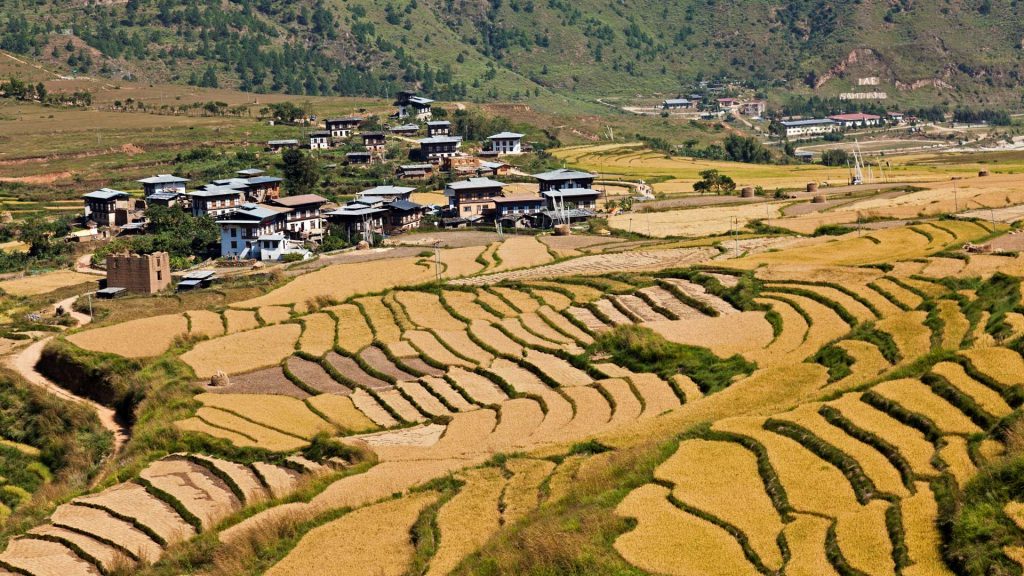
When you vacation in Bhutan, you will come to realize that the Bhutanese are kind, open, and generous. They will leave you with a memorable friendly impression and a wonderful cultural experience after visiting the kingdom.
